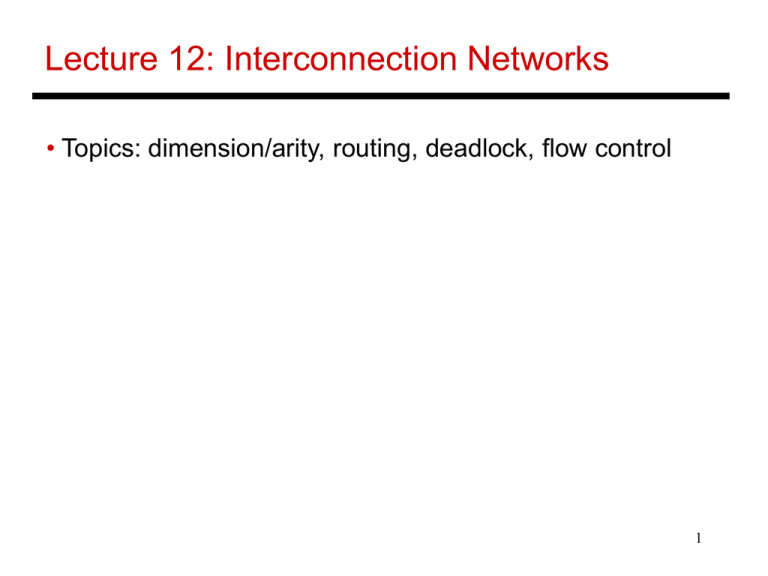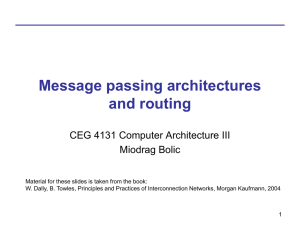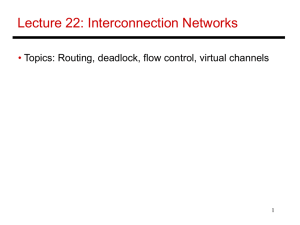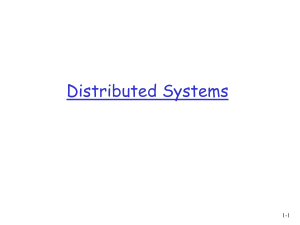Lecture 12: Interconnection Networks • Topics: dimension/arity, routing, deadlock, flow control 1
advertisement

Lecture 12: Interconnection Networks • Topics: dimension/arity, routing, deadlock, flow control 1 Interconnection Networks • Recall: fully connected network, arrays/rings, meshes/tori, trees, butterflies, hypercubes • Consider a k-ary d-cube: a d-dimension array with k elements in each dimension, there are links between elements that differ in one dimension by 1 (mod k) • Number of nodes N = kd Number of switches : Switch degree : Number of links : Pins per node : N 2d + 1 Nd 2wd (with no wraparound) Avg. routing distance: Diameter : Bisection bandwidth : Switch complexity : Should we minimize or maximize dimension? d(k-1)/2 d(k-1) 2wkd-1 (2d + 1)2 2 Bisection Bandwidth Break the kd nodes into two groups such that all elements in group-1 are of the form: [0 - k/2-1] [*][*]...[*] in group-2 are of the form: [k/2 – k] [*][*]...[*] • Each node has an edge to other nodes that differ in only one dimension by one • Any node in group-1 differs from any node in group-2 in at least the first dimension – hence, any edge from group-1 to group-2 is an edge that connects nodes that are identical in d-1 dimensions and differ in the first dimension by 1 • If we fix the co-ordinates of the d-1 dimensions, we can identify two edges: [0, i1,…,id-1] – [k-1, i1,…,id-1] and [k/2-1, i1,…,id-1] – [k/2, i1,…,id-1] : there are totally 2kd-1 edges 3 Dimension • For a fixed machine size N, low-dimension networks have significantly higher latencies for a packet – scalable machines should employ high dimensionality (high cost!) • For a fixed number of pins, message latency decreases at first, then increases (as we increase dimensionality) • What if we keep constant bisection bandwidth? Number of switches : Switch degree : Number of links : Pins per node : N 2d+1 Nd 2wd Avg. routing distance: Diameter : Bisection bandwidth : Switch complexity : N = kd d(k-1)/2 d(k-1) 2wkd-1 (2d + 1)2 4 Routing • Deterministic routing: given the source and destination, there exists a unique route • Adaptive routing: a switch may alter the route in order to deal with unexpected events (faults, congestion) – more complexity in the router vs. potentially better performance • Example of deterministic routing: dimension order routing: send packet along first dimension until destination co-ord (in that dimension) is reached, then next dimension, etc. 5 Deadlock • Deadlock happens when there is a cycle of resource dependencies – a process holds on to a resource (A) and attempts to acquire another resource (B) – A is not relinquished until B is acquired 6 Deadlock Example 4-way switch Input ports Output ports Packets of message 1 Packets of message 2 Packets of message 3 Packets of message 4 Each message is attempting to make a left turn – it must acquire an output port, while still holding on to a series of input and output ports 7 Deadlock-Free Proofs • Number edges and show that all routes will traverse edges in increasing (or decreasing) order – therefore, it will be impossible to have cyclic dependencies • Example: k-ary 2-d array with dimension routing: first route along x-dimension, then along y 1 2 17 18 1 2 18 17 1 2 19 16 1 2 2 1 3 0 2 1 3 0 2 1 3 0 2 1 3 0 8 Breaking Deadlock I • The earlier proof does not apply to tori because of wraparound edges • Partition resources across multiple virtual channels • If a wraparound edge must be used in a torus, travel on virtual channel 1, else travel on virtual channel 0 9 Breaking Deadlock II • Consider the eight possible turns in a 2-d array (note that turns lead to cycles) • By preventing just two turns, cycles can be eliminated • Dimension-order routing disallows four turns • Helps avoid deadlock even in adaptive routing West-First North-Last Negative-First Can allow deadlocks 10 Packets/Flits • A message is broken into multiple packets (each packet has header information that allows the receiver to re-construct the original message) • A packet may itself be broken into flits – flits do not contain additional headers • Two packets can follow different paths to the destination Flits are always ordered and follow the same path • Such an architecture allows the use of a large packet size (low header overhead) and yet allows fine-grained resource allocation on a per-flit basis 11 Flow Control • The routing of a message requires allocation of various resources: the channel (or link), buffers, control state • Bufferless: flits are dropped if there is contention for a link, NACKs are sent back, and the original sender has to re-transmit the packet • Circuit switching: a request is first sent to reserve the channels, the request may be held at an intermediate router until the channel is available (hence, not truly bufferless), ACKs are sent back, and subsequent packets/flits are routed with little effort (good for bulk transfers) 12 Buffered Flow Control • A buffer between two channels decouples the resource allocation for each channel – buffer storage is not as precious a resource as the channel (perhaps, not so true for on-chip networks) Cut-through Channel Channel • Packet-buffer flow control: channels and buffers are allocated per packet Time-Space diagrams H B B B T Store-and-forward 0 1 2 3 0 H B B H B 1 H 2 3 0 1 2 H B B B T H B B B T B T B B T B B B T 3 4 5 6 7 8 9 10 11 12 13 14 13 Cycle Flit-Buffer Flow Control (Wormhole) • Wormhole Flow Control: just like cut-through, but with buffers allocated per flit (not channel) • A head flit must acquire three resources at the next switch before being forwarded: channel control state (virtual channel, one per input port) one flit buffer one flit of channel bandwidth The other flits adopt the same virtual channel as the head and only compete for the buffer and physical channel Consumes much less buffer space than cut-through routing – does not improve channel utilization as another 14 packet cannot cut in (only one VC per input port) Virtual Channel Flow Control • Each switch has multiple virtual channels per phys. channel • Each virtual channel keeps track of the output channel assigned to the head, and pointers to buffered packets • A head flit must allocate the same three resources in the next switch before being forwarded • By having multiple virtual channels per physical channel, two different packets are allowed to utilize the channel and not waste the resource when one packet is idle 15 Example • Wormhole: A is going from Node-1 to Node-4; B is going from Node-0 to Node-5 Node-0 B Node-1 idle A B Node-2 idle Node-3 Traffic Analogy: B is trying to make a left turn; A is trying to go straight; there is no left-only lane with wormhole, but there is one with VC Node-4 Node-5 (blocked, no free VCs/buffers) • Virtual channel: Node-0 B Node-1 A A B A Node-2 Node-3 Node-4 Node-5 (blocked, no free VCs/buffers) 16 Title • Bullet 17







